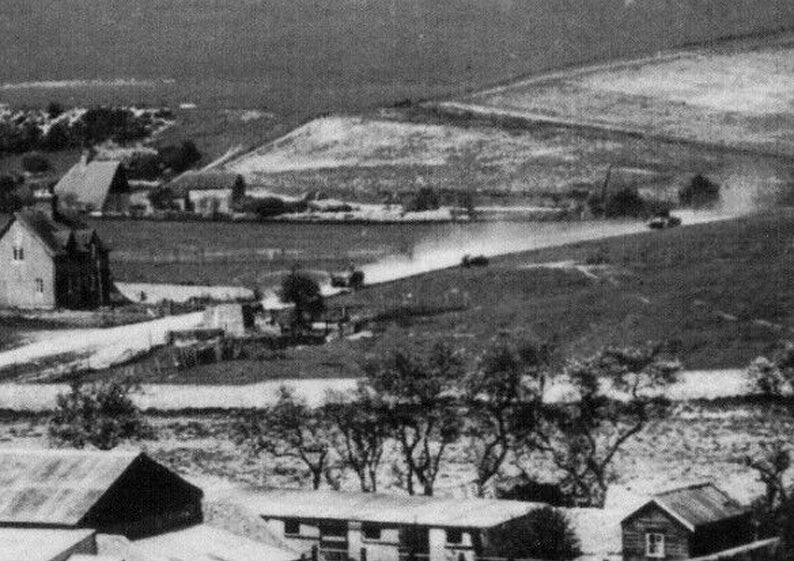


Late August. You park your car in Woodingdean, a suburb of Brighton. (Hang on. Why? Bear with me, as they say.) Woodingdean grew up in the 1920s, when developers sold plots for development, often to former soldiers. The Emperor Haile Selassie, whom Rastafarians believe to be the prophet of the black race, used to live here at the end of the 1930s, in exile from Ethopia. He rented a house from the comedian Max Miller, the Cheeky Chappie. It has since been knocked down and replaced by a row of bungalows.
You marvel at mankind's ability to make mundane settlements out of sites of stupendous natural beauty, in this case rolling hills overlooking the sea. (Or perhaps you think, I shall come and retire here. Could do worse.) You walk past the site of the Sunblest factory, which in the 1950s did for bread what Woodingdean did for the countryside.
And you walk down into a hidden valley. (Hang on, what does hidden' mean when we're in Sussex? - Well, ok, right, comparatively hidden.) The only sounds are the breeze, some skylarks, the odd light aircraft. You walk past fields of wheat, recently scalped, and fields stocked stuffed actually with sheep, along paths bordered with scabious and lady's bedstraw (don't take my word for it, I'm a bit hazy on wildflowers). And at the bottom of the valley is a place with a strange atmosphere. On the face of it, it's simply part of a farm. There are some abandoned farm buildings, and some remains of derelict agricultural machinery, but it feels odd.
The place used to be a hamlet, Balsdean, consisting of a manor house, a cricket ground, a couple of farms, a few cottages, and a Norman chapel which was being used as a barn when the MOD took it over in 1939 to use for target practice. It was reduced to rubble. No cottages, no charming old-school phone boxes left, not like the village of Tyneham in Dorset which was also commandeered by the MOD, and is now something of a tourist attraction.
In 2010 the Brighton band Grasscut released an album 1 inch: mile (Ghostly, weird and enveloping electronica' Sunday Times). It's a psychogeographical trip into the valley, each song referencing some detail of the landscape. You have of course brought the album with you on your phone, so as you pass the site of the chapel, commemorated with a brass plaque, you can listen to Track 6: 1946.
And then you notice what might be the only living evidence of the hamlet: an orchard of plum trees, densely populating a grassy bank. The discovery feels wrong-footing. Yes, this is a farm, but the orchard is on a different scale, contained, domestic. The gnarly, lichen-covered branches of the trees are laden with plums, groaning with them, several different varieties, small and sweet cherry plums, bullaces (which are like small greengages), wild damsons. Naturally you have come equipped with the basket you made on a recent basket-weaving course, so you set to. There is an insane amount of fruit. You marvel at Nature's fecundity (or more likely, you take it for granted), and wonder about bringing a ladder next time. Not necessary, there are so many that can be reached from the ground. You worry mildly that the farmer, who is notorious locally for having threatened to shoot any dog that attacks his sheep, might take exception. But all goes well. Will some even more voracious forager come and scalp the trees before you can return? Nothing to be done.
You take your basket and trudge back past an avenue of trees (Track 7: Muppet - Muppet?), the centre of the old hamlet, up a grassy, chalky, flinty path back to Woodingdean. You pay your respects to Max Miller (catchphrase: Now there's a funny thing'), climb into your car, and go home to make the Pickled Damson recipe from Jessica Seatons' wonderful Gather Cook Feast. (Ok, yes, sorry, that is a flagrant piece of sock-puppetry. Not only is Jess a friend of mine, but I helped out testing the recipes in the book. But you could argue that for that very reason I know better than anyone what a great book it is.)
Or you try this old-school Plum Tart, which you can almost imagine being cooked in the manor house in Balsdean in 1800.
350g puff pastry - make it if you dare, buy it if you don't
500g plums (a minute fraction of what you've collected)
30g butter
50g caster sugar
tsp ground cinnamon
an egg
a little milk
Heat the oven to 200C.
Butter a baking tray. Divide the pastry in half, and roll it out into two equal rectangular strips. Put one of the strips on the baking tray. Stone the plums and lay them hollow side down on the pastry strip, leaving a narrow corridor round the edges. Dot with butter, and sprinkle with sugar and cinnamon. Damp the corridor, and lay the other pastry strip on top. Press the edges together firmly.
Make three incisions in the upper pastry strip.
Brush the top of the tart with a 50-50 mixture of egg yolk and milk. Sprinkle with extra sugar, and bake for 30 minutes.
Best eaten lukewarm, with crme frache.
Words by Orlando Gough.
TOAST Co founder Jessica Seaton's Cook Book, Gather Cook Feast available here.
Add a comment